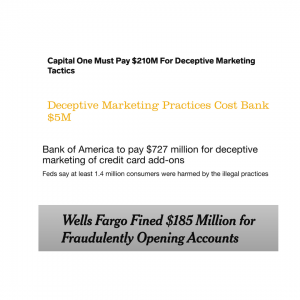Imagine a movie about a kid who moves to a new city. It’s halfway through the year, friendships are already in place, and he feels left out. His solution? Pay other kids to be his friends. Surrounded by classmates in the schoolyard, he looks popular. But how valuable are those relationships when they are bought?
Would you feel good about this approach if it were your child?
Financial services companies have been marketing themselves like this for decades—pushing deals, incentives, and special offers to attract customers in the best traditions of the used car lot.
Banks and financial services companies know that buying customers with upfront incentives works. The majority of customers who take the bait will stick around for the long term, and the bank can profit from them for decades.
Why? Because there is very little differentiation between conventional banks. Their products provide poor value for money. In some cases, financial services companies have even crossed the line from aggressive marketing into outright deception.
The uncomfortable truth is that conventional banks have been profiting at the expense of consumers for decades.
This helps explain why retail banks are three times more profitable than the market average.

From a consumer’s viewpoint, the model feels hollow.
Consumers know the difference between being courted and being cared for—and increasingly, they’re looking for financial providers who deliver substance over spin.
Banks are caught in a cycle where weak products are propped up by enormous marketing budgets.
For what should be a commoditized utility, that is an extraordinary cost. Yet switching remains rare unless customers are lured by incentives.
This cycle is best understood through the lens of Customer Acquisition Cost (CAC)—the total amount a bank spends to win a new customer through marketing, incentives, and affiliate fees.
High CAC sets off a chain reaction:
The result: poorer customer experiences, higher fees, and diminishing returns. Consumers lose.
But this cycle isn’t inevitable. Other parts of financial services have shown a different path. Vanguard, for example, transformed retail investing by focusing on value for money.
The less Vanguard charged, the more people were naturally attracted to them. They promised and delivered fantastic value. Customers came because of the product, not because of incentives.
Imagine if this model were applied to retail banking:
Such products would attract customers on their own merit, driving pull marketing instead of push. Acquisition costs would fall, inactive rates would drop, and providers could redirect savings back to customers.
Lowering CAC changes the entire economics of banking:
The result would be a new model of banking—one where customers are the ultimate beneficiaries.
If the industry continues on the current trajectory:
The winners of tomorrow will be those who act now to break the cycle.
The next wave of leaders in financial services will be those who compete on value, not gimmicks. Buying customers is expensive, inefficient, and unsustainable. Building loyalty through products that enrich the customer is the only real path forward.
The choice is stark: keep buying loyalty at great cost, or start building it sustainably.
The above does NOT constitute an offer, solicitation of an offer, nor advice to buy or sell specific securities. The opinions listed above are not the opinions of Unifimoney Inc. or Unifimoney RIA, Inc. but represent the opinions of independent contributors. These contributors may or may not hold positions in the stocks discussed. Investors should always independently research any stocks listed and form their own opinions, while recognizing that any investments made may lose value, are not bank guaranteed and are not FDIC insured.